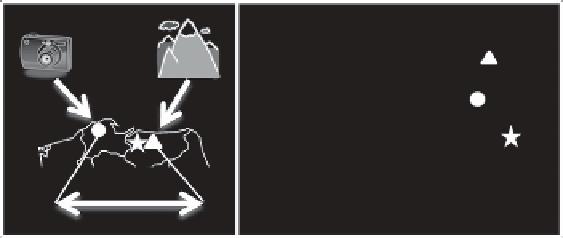Database Reference
In-Depth Information
Photo content: Mount Everest
Everest coordinates: c1=(x1, y1)
Camera coordinates: c2=(x2, y2)
User photo coordinates: c3=(x3, y3)
Distance C1, C2 = 100 Km
Distance C1, C3 = 10 Km
distance
Figure 16.4 Comparison of device precision and semantic precision.
This distance could be considerable. Let us imagine that the content represented
in the photo is Mount Everest. The user with the camera is necessarily far from
the mountain peak to include it into the photo. As shown in Figure
16.4
on the
right side, the mountain and the camera could be consistently far one from the
other.
These last two examples illustrate that there is a discrepancy between the
location of the content (the registered device location at the time the message is
sent or the photo is taken) and the geographic content contained in the message
itself. The location of the device is not necessarily equal to the location of the
reported content: they can overlap or be far away, as in the examples. This
inconsistency is not of a technological nature, but will always include semantic
aspects.
16.5 Open Issues
Finally, wewant to raise newkey questions that we leave open for future research,
which we believe will constitute interesting problems for the communities of
computer scientists, sociologists, physicists, and economists in the years to come.
Huge amounts of socially generated media resources on the Internet are a result
of experience sharing by web communities. This fast-growing media collection
records our culture, society, and environment, and provides opportunities to
mine semantic and social knowledge of the world. Moreover, recent popularity
of location-based social services, such as Foursquare, Gowalla, and Hot-Potato,
has generated a huge amount of detailed location and event tags. It covers not
only popular landmarks, but also obscure places, thus providing broad coverage
of locations in unprecedented scales. This large amount of information, often
unstructured, opens a first research issue in the field of real time analysis of data
flow. The research broadly covers several aspects, such as very large data repos-
itory in nonstandard data structures, extracting semantic aggregation of tags,

